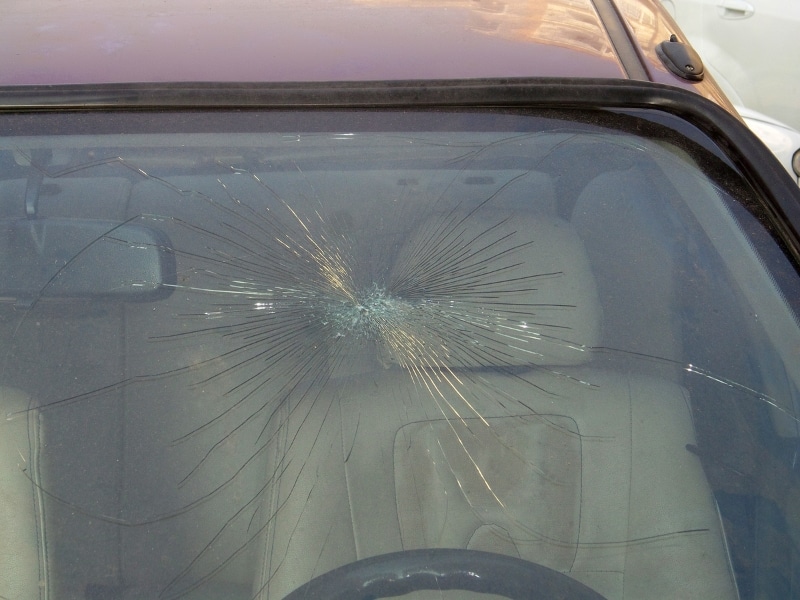Driving with a windscreen crack is more than just a minor inconvenience. It can compromise your safety and even lead to more severe issues. Windscreen cracks often start small but can escalate quickly, making them a risk to drivers and passengers. This article will explore why driving with a windscreen crack is dangerous, what can happen if left unchecked, and how to prevent it.
What is a windscreen crack, and how does it occur?
A windscreen crack is any visible damage that forms on the surface of your vehicle’s windscreen. Cracks can vary in size and severity, but they all compromise the glass’s strength regardless of their size.
Common causes of windscreen cracks:
- Stone chips: A small stone or debris hitting the windscreen can create a chip that grows over time.
- Temperature fluctuations: Sudden temperature changes, such as blasting your heater on a cold morning, can cause cracks to form.
- Accidents or collisions: A more severe impact from an accident can cause a large crack or shattering of the windscreen.
- Stress and pressure: The windscreen may crack over time due to the pressure from constant vibrations while driving.
Windscreen cracks typically occur due to stones, accidents, or extreme temperatures. They can range from minor chips to large, visible cracks affecting your vehicle’s performance.
Why is driving with a windscreen crack dangerous?
Driving with a cracked windscreen can be hazardous for several reasons. While a small crack might seem harmless, it poses safety risks you should not overlook.
Risks associated with cracked windscreens:
Risks | Explanation |
Impaired visibility | Cracks obstruct your view, hindering quick reactions to road hazards. |
Weakened structural integrity | Windscreen cracks reduce support during collisions, compromising vehicle safety. |
Glare & reflection | Cracks cause glare, making it harder to drive safely in daylight or at night. |
Further cracking | Rough roads or extreme temperatures can cause cracks to spread, increasing damage. |
A cracked windscreen presents multiple dangers, from poor visibility and structural weakening to potential glare and further damage. It’s crucial to address these issues promptly to ensure your safety on the road.
Does the size of the crack affect driving safety?
You might wonder if the size of the crack in your windscreen really matters when it comes to driving safety. The answer is yes—even small cracks can lead to significant risks.
How the size of the crack impacts safety:
- Small cracks: Even small cracks can affect your visibility by distorting the light passing through. They may also grow over time due to vibration or temperature changes.
- Large cracks: Larger cracks or chips significantly obstruct your line of sight and increase the likelihood of complete glass shattering in the event of an accident.
- Location of the crack: Cracks in areas that affect the driver’s line of sight, such as the centre of the windscreen, are more dangerous than those near the edges.
The size of the crack plays a crucial role in your safety. Small cracks can grow and compromise visibility, while larger cracks increase the risk of further damage and glass shattering.
How can weather conditions worsen a cracked windscreen?
Weather conditions can significantly contribute to the deterioration of a cracked windscreen. Extreme temperature changes due to climate change in Sydney can cause the crack to expand, making the damage worse.
How weather affects a cracked windscreen:
Weather Condition | Effect on Windscreen Crack |
Heat | This causes glass to expand, increasing stress and potentially growing the crack. |
Cold | Freezing temperatures contract the crack, making it broader and deeper. |
Rain | Water seeps into cracks, weakening the glass and exacerbating the damage. |
Humidity | Promotes corrosion of the windscreen frame, facilitating crack spread. |
Sudden temperature shifts | Rapid temperature changes cause thermal stress, causing cracks to expand quickly. |
Various weather conditions—heat, cold, rain, humidity, and sudden temperature changes—can aggravate a windscreen crack, accelerating its spread and causing further damage.
Can a windscreen crack lead to more severe damage?
Yes, a crack in your windscreen can worsen over time, leading to more severe damage. If left unchecked, it can compromise the structural integrity of the entire windscreen.
How cracks progress:
- Cracks can spread: A small crack may slowly grow, eventually leading to a larger, more dangerous fracture.
- Shattering risk: A cracked windscreen is likelier to shatter in a collision. Flying glass can cause serious injury or even death.
- Higher repair costs: Repairing a small crack is often cheaper than replacing a shattered windscreen. However, a simple repair can turn into an expensive replacement if left too long.
A small crack can lead to more extensive fractures, increasing the risk of the windscreen shattering. Additionally, delaying repairs can result in higher costs in the long run.
When should you get a windscreen crack repaired?
Timing is crucial when repairing a cracked windscreen. The earlier you address the damage, the better.
When to repair:
- Immediately after noticing damage: If you spot a crack or chip, have it checked out right away to determine if it’s repairable.
- When the crack affects your visibility: If the crack obstructs your line of sight, even slightly, it should be repaired immediately.
- When the crack is spreading: If it is growing more prominent, it’s crucial to seek professional windscreen repair services before it worsens.
- If you’re unsure about the extent of the damage: If you’re uncertain whether the crack is repairable or requires replacement, always consult a professional.
Repairing a windscreen crack as soon as possible is crucial to prevent further damage and ensure your safety on the road. Waiting too long can lead to more expensive repairs or replacements.
How do you prevent a windscreen crack from happening?
While it’s not always possible to prevent cracks, there are steps you can take to reduce the likelihood of damage occurring.
Tips to prevent windscreen cracks:
- Avoid parking under trees: Tree branches can fall and hit your windscreen, causing chips or cracks.
- Drive cautiously: Avoid driving too close to other vehicles, especially on gravel roads or highways where debris can fly up and hit your windscreen.
- Fix chips early: Small chips can be repaired before they become cracks, so fix them as soon as possible.
- Regularly inspect your windscreen: Check for chips and cracks regularly, especially after long trips or during harsh weather conditions.
Regular inspections, keeping a safe distance from other vehicles, and using protective measures can help prevent windscreen cracks from occurring.
Stay safe on the road
Driving with a windscreen crack is not something you should take lightly. Whether it’s a small chip or a large crack, the risks to your safety are significant. From impaired visibility to increased risk of shattering, a cracked windscreen can lead to dangerous driving conditions. It’s best to address a crack immediately to ensure your safety and prevent further damage.
Need a quick windscreen fix? Get in touch with GRS Windscreen PRO for reliable, on-the-go repairs.


